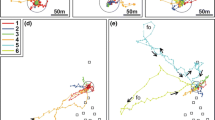Summary
-
1.
Honeybees learn the location of a source of sucrose in relation to the positions of visual landmarks. It is shown here that bees pay most attention to those landmarks which are close to the sucrose and which will therefore guide a bee most accurately to its goal.
-
2.
Individually marked bees were trained to collect sucrose from a reservoir whose location was specified by an array of landmarks, with individual landmarks placed at different distances from the reservoir. Once trained, the bees' flight path was recorded in tests with the sucrose removed. In these tests, the array of landmarks was transformed from the training configuration to provide two possible sites for the sucrose. One was defined by the landmarks close to the sucrose reservoir in training, the other by more distant landmarks. In all experiments (Figs.1, 2 and 3), bees spent more time flying in the site defined by the close landmarks. They did so even when the apparent sizes of the close and distant landmarks viewed from the reservoir were the same. We conclude that bees learn the distance of landmarks from the goal, and that, during their search for the goal, they weight nearer landmarks more heavily than distant ones.
-
3.
Landmarks are also weighted according to their (apparent) size. Bees were trained to find sucrose at a reservoir placed equidistantly from different-sized landmarks. Tests were given with the training array stretched to provide two possible sites for the sucrose. One site was specified by the large, the other by the small landmarks. Bees spent more time flying in the site defined by the larger landmarks (Fig. 5).
-
4.
We discuss, with the aid of computer simulation, different ways in which the distance between landmark and goal could influence a bee's searching behaviour.
Similar content being viewed by others
References
Cartwright BA, Collett TS (1982) How honeybees use landmarks to guide their return to a food source. Nature 295:560–564
Cartwright BA, Collett TS (1983) Landmark learning in bees: experiments and models. J Comp Physiol 151:521–543
Cartwright BA, Collett TS (1987) Landmark-maps for honeybees. Biol Cybern (in press)
Cheng K, Collett TS, Wehner R (1986) Honeybees learn the colours of landmarks. J Comp Physiol A 159:69–73
Maurer B (1980) Die visuelle Lokalisation der Honigbiene (Apis mellifera) anhand eines experimentell variierbaren Landmarkenpanoramas. PhD thesis, University of Zürich
Pelzer V (1985) Die Bedeutung von Helligkeits- und Farbkontrast bei der Erkennung und Lokalisation der Futterquelle anhand künstlicher Nahmarken: Verhaltensexperimente mitApis mellifera. PhD thesis, University of Zürich
Wehner R (1981) Spatial vision of arthropods. In: Autrum H (ed) Comparative physiology and evolution of vision in invertebrates (Handbook of sensory physiology, vol VII 6C). Springer, Berlin Heidelberg New York, pp 287–361
Zeil J, Wittmann D (1987) Visual orientation towards the nest in a stingless bee (Tetragonisca angustula).In: Rembold H, Eder J (eds) Biology and chemistry of social insects. J. Peperny, München (in press)
Author information
Authors and Affiliations
Rights and permissions
About this article
Cite this article
Cheng, K., Collett, T.S., Pickhard, A. et al. The use of visual landmarks by honeybees: Bees weight landmarks according to their distance from the goal. J. Comp. Physiol. 161, 469–475 (1987). https://doi.org/10.1007/BF00603972
Accepted:
Issue Date:
DOI: https://doi.org/10.1007/BF00603972




